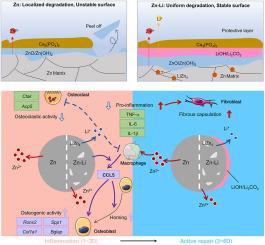锂微调锌基种植体的生物降解,通过免疫调节促进骨整合
IF 18
1区 医学
Q1 ENGINEERING, BIOMEDICAL
引用次数: 0
摘要
生物可降解合金在植入过程中表现出复杂的降解动力学,显著影响宿主的反应,对实现稳定的骨整合提出了挑战。因此,调整这些植入物的生物降解特征,为骨组织再生建立一个导电的组织微环境是至关重要的。在这项研究中,我们证明了锌-锂合金在骨-种植体界面形成一层含锂的降解产物,以适应骨再生过程。在炎症早期,合金中锂离子(Li+)和锌离子(Zn2+)的受控释放诱导巨噬细胞产生趋化因子(C-C基序)配体5 (CCL5),促进成骨谱系细胞的募集和分化。由于随后形成保护性骨-种植体界面,Zn-Li合金的活性Zn2+释放被抑制,而Li+继续表现出抗炎作用并抑制破骨细胞的发生。因此,锌基合金中Li的存在可以防止纯锌植入物中常见的长时间炎症和纤维包膜。我们的研究结果为新型可生物降解种植体的发展提供了有价值的见解,旨在通过生物适应实现骨整合。本文章由计算机程序翻译,如有差异,请以英文原文为准。

Lithium fine-tunes biodegradation of Zn-based implant to promote osseointegration through immunomodulation
The intricate degradation dynamics exhibited by biodegradable alloys significantly influence host responses during the implantation process, posing challenges in achieving stable osseointegration. It is thus critical to tailor the biodegradation profiles of these implants to establish a conductive tissue microenvironment for bone tissue regeneration. In this study, we demonstrate that Zn-Li alloy forms a layer of Li-containing degradation products at the bone-implant interface to accommodate the bone regeneration process. During the early inflammatory phase, the controlled release of lithium ions (Li+) and zinc ions (Zn2+) from the alloy induces chemokine (C-C motif) ligand 5 (CCL5) production from macrophages, which promotes the recruitment and differentiation of osteoblastic lineage cells. As a protective bone-implant interface is formed subsequently, the active Zn2+ release from Zn-Li alloy is suppressed while Li+ continues to exhibit anti-inflammatory effects and inhibit osteoclastogenesis. Therefore, the presence of Li in Zn-based alloy prevents the prolonged inflammation and fibrous capsulation typically seen in pure Zn implants. Our findings offer valuable insights into the development of novel biodegradable implants aimed at achieving osseointegration through bioadaption.
求助全文
通过发布文献求助,成功后即可免费获取论文全文。
去求助
来源期刊

Bioactive Materials
Biochemistry, Genetics and Molecular Biology-Biotechnology
CiteScore
28.00
自引率
6.30%
发文量
436
审稿时长
20 days
期刊介绍:
Bioactive Materials is a peer-reviewed research publication that focuses on advancements in bioactive materials. The journal accepts research papers, reviews, and rapid communications in the field of next-generation biomaterials that interact with cells, tissues, and organs in various living organisms.
The primary goal of Bioactive Materials is to promote the science and engineering of biomaterials that exhibit adaptiveness to the biological environment. These materials are specifically designed to stimulate or direct appropriate cell and tissue responses or regulate interactions with microorganisms.
The journal covers a wide range of bioactive materials, including those that are engineered or designed in terms of their physical form (e.g. particulate, fiber), topology (e.g. porosity, surface roughness), or dimensions (ranging from macro to nano-scales). Contributions are sought from the following categories of bioactive materials:
Bioactive metals and alloys
Bioactive inorganics: ceramics, glasses, and carbon-based materials
Bioactive polymers and gels
Bioactive materials derived from natural sources
Bioactive composites
These materials find applications in human and veterinary medicine, such as implants, tissue engineering scaffolds, cell/drug/gene carriers, as well as imaging and sensing devices.
 求助内容:
求助内容: 应助结果提醒方式:
应助结果提醒方式:


